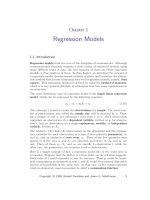foundations of behavior
Bạn đang xem bản rút gọn của tài liệu. Xem và tải ngay bản đầy đủ của tài liệu tại đây (580.46 KB, 53 trang )
ninth edition
STEPHEN P. ROBBINS
© 2007 Prentice Hall, Inc.
© 2007 Prentice Hall, Inc.
All rights reserved.
All rights reserved.
PowerPoint Presentation by Charlie Cook
PowerPoint Presentation by Charlie Cook
The University of West Alabama
The University of West Alabama
MARY COULTER
Foundations
Foundations
of Behavior
of Behavior
Chapter
Chapter
14
14
© 2007 Prentice Hall, Inc. All rights
reserved.
14–2
L E A R N I N G O U T L I N E
L E A R N I N G O U T L I N E
Follow this Learning Outline as you read and study this chapter.
Follow this Learning Outline as you read and study this chapter.
Why Look at Individual Behavior?
Why Look at Individual Behavior?
•
Explain why the concept of an organization as an iceberg
Explain why the concept of an organization as an iceberg
is important to understanding organizational behavior.
is important to understanding organizational behavior.
•
Describe the focus and the goals of organizational
Describe the focus and the goals of organizational
behavior.
behavior.
•
Define the six important employee behaviors that
Define the six important employee behaviors that
managers want to explain, predict, and influence.
managers want to explain, predict, and influence.
Attitudes
Attitudes
•
Describe the three components of an attitude.
Describe the three components of an attitude.
•
Discuss three job-related attitudes.
Discuss three job-related attitudes.
•
Describe the impact job satisfaction has on employee
Describe the impact job satisfaction has on employee
behavior.
behavior.
© 2007 Prentice Hall, Inc. All rights
reserved.
14–3
L E A R N I N G O U T L I N E (cont’d)
L E A R N I N G O U T L I N E (cont’d)
Follow this Learning Outline as you read and study this chapter.
Follow this Learning Outline as you read and study this chapter.
Attitudes (cont’d)
Attitudes (cont’d)
•
Explain how individuals reconcile inconsistencies
Explain how individuals reconcile inconsistencies
between attitudes and behavior.
between attitudes and behavior.
•
Personality
Personality
•
Contrast the MBTI and the big-five model of personality.
Contrast the MBTI and the big-five model of personality.
•
Describe the five personality traits that have proved to be
Describe the five personality traits that have proved to be
most powerful in explaining individual behavior in
most powerful in explaining individual behavior in
organizations.
organizations.
•
Explain how emotions and emotional intelligence impact
Explain how emotions and emotional intelligence impact
behavior.
behavior.
© 2007 Prentice Hall, Inc. All rights
reserved.
14–4
L E A R N I N G O U T L I N E (cont’d)
L E A R N I N G O U T L I N E (cont’d)
Follow this Learning Outline as you read and study this chapter.
Follow this Learning Outline as you read and study this chapter.
Perception
Perception
•
Explain how an understanding of perception can help
Explain how an understanding of perception can help
managers.
managers.
•
Describe the key elements of attribution theory.
Describe the key elements of attribution theory.
•
Discuss how the fundamental attribution error and self-
Discuss how the fundamental attribution error and self-
serving bias can distort attributions.
serving bias can distort attributions.
•
Name three shortcuts used in judging others.
Name three shortcuts used in judging others.
Learning
Learning
•
Explain how operant conditioning helps managers
Explain how operant conditioning helps managers
understand, predict, and influence behavior.
understand, predict, and influence behavior.
•
Describe the implications of social learning theory for
Describe the implications of social learning theory for
managing people at work.
managing people at work.
© 2007 Prentice Hall, Inc. All rights
reserved.
14–5
L E A R N I N G O U T L I N E (cont’d)
L E A R N I N G O U T L I N E (cont’d)
Follow this Learning Outline as you read and study this chapter.
Follow this Learning Outline as you read and study this chapter.
Learning
Learning
•
Discuss how managers can shape behavior.
Discuss how managers can shape behavior.
Contemporary OB Issues
Contemporary OB Issues
•
Describe the challenges managers face in managing Gen
Describe the challenges managers face in managing Gen
Y workers.
Y workers.
•
Explain what managers can do to deal with workplace
Explain what managers can do to deal with workplace
misbehavior.
misbehavior.
© 2007 Prentice Hall, Inc. All rights
reserved.
14–6
Why Look at Individual Behavior?
Why Look at Individual Behavior?
•
Organizational Behavior (OB)
Organizational Behavior (OB)
The actions of people at work
The actions of people at work
•
Focus of Organizational Behavior
Focus of Organizational Behavior
Individual behavior
Individual behavior
Attitudes, personality, perception, learning, and motivation
Attitudes, personality, perception, learning, and motivation
Group behavior
Group behavior
Norms, roles, team building, leadership, and conflict
Norms, roles, team building, leadership, and conflict
•
Goals of Organizational Behavior
Goals of Organizational Behavior
To explain, predict and influence behavior.
To explain, predict and influence behavior.
© 2007 Prentice Hall, Inc. All rights
reserved.
14–7
Exhibit 14.1
Exhibit 14.1
The Organization as an Iceberg
The Organization as an Iceberg
© 2007 Prentice Hall, Inc. All rights
reserved.
14–8
Important Employee Behaviors
Important Employee Behaviors
•
Employee Productivity
Employee Productivity
A performance measure of both efficiency and
A performance measure of both efficiency and
effectiveness
effectiveness
•
Absenteeism
Absenteeism
The failure to report to work when expected
The failure to report to work when expected
•
Turnover
Turnover
The voluntary and involuntary
The voluntary and involuntary
permanent withdrawal from
permanent withdrawal from
an organization
an organization
© 2007 Prentice Hall, Inc. All rights
reserved.
14–9
Important Employee Behaviors (cont’d)
Important Employee Behaviors (cont’d)
•
Organizational Citizenship Behavior (OCB)
Organizational Citizenship Behavior (OCB)
Discretionary behavior that is not a part of an employee’s
Discretionary behavior that is not a part of an employee’s
formal job requirements, but which promotes the effective
formal job requirements, but which promotes the effective
functioning of the organization.
functioning of the organization.
•
Job Satisfaction
Job Satisfaction
The individual’s general attitude
The individual’s general attitude
toward his or her job
toward his or her job
© 2007 Prentice Hall, Inc. All rights
reserved.
14–10
Important Employee Behaviors (cont’d)
Important Employee Behaviors (cont’d)
•
Workplace Misbehavior
Workplace Misbehavior
Any intentional employee behavior that has negative
Any intentional employee behavior that has negative
consequences for the organization or individuals within the
consequences for the organization or individuals within the
organization.
organization.
Types of Misbehavior
Types of Misbehavior
Deviance
Deviance
Aggression
Aggression
Antisocial behavior
Antisocial behavior
Violence
Violence
© 2007 Prentice Hall, Inc. All rights
reserved.
14–11
Psychological Factors Affecting
Psychological Factors Affecting
Employee Behavior
Employee Behavior
•
Attitudes
Attitudes
•
Personality
Personality
•
Perception
Perception
•
Learning
Learning
•
Attitudes
Attitudes
•
Personality
Personality
•
Perception
Perception
•
Learning
Learning
•
Employee
Employee
Productivity
Productivity
•
Absenteeism
Absenteeism
•
Turnover
Turnover
•
Organizational
Organizational
Citizenship
Citizenship
•
Job Satisfaction
Job Satisfaction
•
Workplace
Workplace
Misbehavior
Misbehavior
•
Employee
Employee
Productivity
Productivity
•
Absenteeism
Absenteeism
•
Turnover
Turnover
•
Organizational
Organizational
Citizenship
Citizenship
•
Job Satisfaction
Job Satisfaction
•
Workplace
Workplace
Misbehavior
Misbehavior
© 2007 Prentice Hall, Inc. All rights
reserved.
14–12
Psychological Factors
Psychological Factors
•
Attitudes
Attitudes
Evaluative statements
Evaluative statements
—either favorable or unfavorable—
—either favorable or unfavorable—
concerning objects, people, or events.
concerning objects, people, or events.
•
Components Of An Attitude
Components Of An Attitude
Cognitive component:
Cognitive component:
the beliefs, opinions, knowledge, or
the beliefs, opinions, knowledge, or
information held by a person.
information held by a person.
Affective component:
Affective component:
the emotional or feeling part of an
the emotional or feeling part of an
attitude.
attitude.
Behavioral component:
Behavioral component:
the intention to behave in a certain
the intention to behave in a certain
way.
way.
© 2007 Prentice Hall, Inc. All rights
reserved.
14–13
Psychological Factors (cont’d)
Psychological Factors (cont’d)
•
Job Satisfaction
Job Satisfaction
Job satisfaction is affected by level of income earned and
Job satisfaction is affected by level of income earned and
by the type of job a worker does.
by the type of job a worker does.
•
Job Satisfaction and Productivity
Job Satisfaction and Productivity
For individuals, productivity appears to lead to job
For individuals, productivity appears to lead to job
satisfaction.
satisfaction.
For organizations, those with more satisfied employees are
For organizations, those with more satisfied employees are
more effective than those with less satisfied employees.
more effective than those with less satisfied employees.
© 2007 Prentice Hall, Inc. All rights
reserved.
14–14
Psychological Factors (cont’d)
Psychological Factors (cont’d)
•
Job Satisfaction and Absenteeism
Job Satisfaction and Absenteeism
Satisfied employees tend to have lower levels of
Satisfied employees tend to have lower levels of
absenteeism.
absenteeism.
•
Job Satisfaction and Turnover
Job Satisfaction and Turnover
Satisfied employees have lower levels of turnover;
Satisfied employees have lower levels of turnover;
dissatisfied employees have higher levels of turnover.
dissatisfied employees have higher levels of turnover.
Turnover is affected by the level of employee performance.
Turnover is affected by the level of employee performance.
The preferential treatment afforded superior employees
The preferential treatment afforded superior employees
makes satisfaction less important in predicting their turnover
makes satisfaction less important in predicting their turnover
decisions.
decisions.
© 2007 Prentice Hall, Inc. All rights
reserved.
14–15
Psychological Factors (cont’d)
Psychological Factors (cont’d)
•
Job Satisfaction and Customer Satisfaction
Job Satisfaction and Customer Satisfaction
The level of job satisfaction for frontline employees is
The level of job satisfaction for frontline employees is
related to increased customer satisfaction and loyalty.
related to increased customer satisfaction and loyalty.
Interaction with dissatisfied customers can increase an
Interaction with dissatisfied customers can increase an
employee’s job dissatisfaction.
employee’s job dissatisfaction.
Actions to increase job satisfaction for customer service
Actions to increase job satisfaction for customer service
workers:
workers:
Hire upbeat and friendly employees.
Hire upbeat and friendly employees.
Reward superior customer service.
Reward superior customer service.
Provide a positive work climate.
Provide a positive work climate.
Use attitude surveys to track employee satisfaction.
Use attitude surveys to track employee satisfaction.
© 2007 Prentice Hall, Inc. All rights
reserved.
14–16
Psychological Factors (cont’d)
Psychological Factors (cont’d)
•
Job Satisfaction and Workplace Misbehavior
Job Satisfaction and Workplace Misbehavior
Dissatisfied employees will respond somehow
Dissatisfied employees will respond somehow
Not easy to predict exactly how they’ll respond
Not easy to predict exactly how they’ll respond
© 2007 Prentice Hall, Inc. All rights
reserved.
14–17
Psychological Factors (cont’d)
Psychological Factors (cont’d)
•
Job Involvement
Job Involvement
The degree to which an employee identifies with his or her
The degree to which an employee identifies with his or her
job, actively participates in it, and considers his or her
job, actively participates in it, and considers his or her
performance to be important to his or her self-worth.
performance to be important to his or her self-worth.
High levels of commitment are related to fewer absences and
High levels of commitment are related to fewer absences and
lower resignation rates.
lower resignation rates.
© 2007 Prentice Hall, Inc. All rights
reserved.
14–18
Psychological Factors (cont’d)
Psychological Factors (cont’d)
•
Organizational Commitment
Organizational Commitment
Is the degree to which an employee identifies with a
Is the degree to which an employee identifies with a
particular organization and its goals and wishes to maintain
particular organization and its goals and wishes to maintain
membership in the organization.
membership in the organization.
Leads to lower levels of both absenteeism and turnover.
Leads to lower levels of both absenteeism and turnover.
Could be becoming an outmoded measure as the number of
Could be becoming an outmoded measure as the number of
workers who change employers increases.
workers who change employers increases.
© 2007 Prentice Hall, Inc. All rights
reserved.
14–19
Psychological Factors (cont’d)
Psychological Factors (cont’d)
•
Perceived Organizational Support
Perceived Organizational Support
Is the general belief of employees that their organization
Is the general belief of employees that their organization
values their contribution and cares about their well-being.
values their contribution and cares about their well-being.
Represents the commitment of the organization to the
Represents the commitment of the organization to the
employee.
employee.
Providing high levels of support increases job satisfaction
Providing high levels of support increases job satisfaction
and lower turnover.
and lower turnover.
© 2007 Prentice Hall, Inc. All rights
reserved.
14–20
Attitudes and Consistency
Attitudes and Consistency
•
People seek consistency in two ways:
People seek consistency in two ways:
Consistency among their attitudes.
Consistency among their attitudes.
Consistency between their attitudes and behaviors.
Consistency between their attitudes and behaviors.
•
If an inconsistency arises, individuals:
If an inconsistency arises, individuals:
Alter their attitudes
Alter their attitudes
or
or
Alter their behavior
Alter their behavior
or
or
Develop a rationalization for the inconsistency
Develop a rationalization for the inconsistency
© 2007 Prentice Hall, Inc. All rights
reserved.
14–21
Cognitive Dissonance Theory
Cognitive Dissonance Theory
•
Cognitive Dissonance
Cognitive Dissonance
Any incompatibility or inconsistency between attitudes or
Any incompatibility or inconsistency between attitudes or
between behavior and attitudes.
between behavior and attitudes.
Any form of inconsistency is uncomfortable and individuals
Any form of inconsistency is uncomfortable and individuals
will try to reduce the dissonance.
will try to reduce the dissonance.
The intensity of the desire to reduce the dissonance is
The intensity of the desire to reduce the dissonance is
influenced by:
influenced by:
The importance of the factors creating the dissonance.
The importance of the factors creating the dissonance.
The degree to which an individual believes that the factors
The degree to which an individual believes that the factors
causing the dissonance are controllable.
causing the dissonance are controllable.
Rewards available to compensate for the dissonance.
Rewards available to compensate for the dissonance.
© 2007 Prentice Hall, Inc. All rights
reserved.
14–22
Attitude Surveys
Attitude Surveys
•
Attitude Surveys
Attitude Surveys
A instrument/document that presents employees with a set
A instrument/document that presents employees with a set
of statements or questions eliciting how they feel about
of statements or questions eliciting how they feel about
their jobs, work groups, supervisors, or their organization.
their jobs, work groups, supervisors, or their organization.
Provide management with feedback on employee
Provide management with feedback on employee
perceptions of the organization and their jobs.
perceptions of the organization and their jobs.
© 2007 Prentice Hall, Inc. All rights
reserved.
14–23
Exhibit 14.2
Exhibit 14.2
Sample Attitude Survey
Sample Attitude Survey
Source: Based on T. Lammers, “The Essential Employee Survey,” Inc., December 1992, pp. 159–161.
© 2007 Prentice Hall, Inc. All rights
reserved.
14–24
The Importance of Attitudes
The Importance of Attitudes
•
Implication for Managers
Implication for Managers
Attitudes warn of potential behavioral problems:
Attitudes warn of potential behavioral problems:
Managers should do things that generate the positive
Managers should do things that generate the positive
attitudes that reduce absenteeism and turnover.
attitudes that reduce absenteeism and turnover.
Attitudes influence behaviors of employees:
Attitudes influence behaviors of employees:
Managers should focus on helping employees become more
Managers should focus on helping employees become more
productive to increase job satisfaction.
productive to increase job satisfaction.
Employees will try to reduce dissonance unless:
Employees will try to reduce dissonance unless:
Managers identify the external sources of dissonance.
Managers identify the external sources of dissonance.
Managers provide rewards compensating for the dissonance.
Managers provide rewards compensating for the dissonance.
© 2007 Prentice Hall, Inc. All rights
reserved.
14–25
Personality
Personality
•
Personality
Personality
The unique combination of psychological characteristics
The unique combination of psychological characteristics
(measurable traits) that affect how a person reacts and
(measurable traits) that affect how a person reacts and
interacts with others.
interacts with others.





![mathematical foundations of scientific visualization, computer graphics, and massive data exploration [electronic resource]](https://media.store123doc.com/images/document/14/y/up/medium_upb1401358803.jpg)



